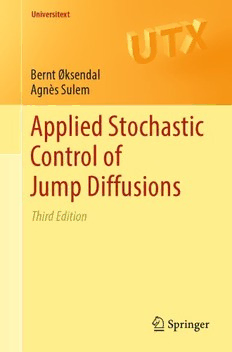Table Of ContentUniversitext
Bernt Øksendal
Agnès Sulem
Applied Stochastic
Control of
Jump Diffusions
Third Edition
Universitext
Universitext
Series Editors
Sheldon Axler
San Francisco State University, San Francisco, CA, USA
Carles Casacuberta
Universitat de Barcelona, Barcelona, Spain
Angus MacIntyre
Queen Mary University of London, London, UK
Kenneth Ribet
University of California, Berkeley, CA, USA
Claude Sabbah
École Polytechnique, CNRS, Université Paris-Saclay,
Palaiseau, France
Endre Süli
University of Oxford, Oxford, UK
Wojbor A. Woyczyński,
Case Western Reserve University, Cleveland, OH, USA
Universitext is a series of textbooks that presents material from a wide variety of
mathematical disciplines at master’s level and beyond. The books, often well
class-tested by their author, may have an informal, personal even experimental
approachtotheirsubjectmatter.Someofthemostsuccessfulandestablishedbooks
intheserieshaveevolvedthroughseveraleditions,alwaysfollowingtheevolution
of teaching curricula, to very polished texts.
Thus as research topics trickle down into graduate-level teaching, first textbooks
written for new, cutting-edge courses may make their way into Universitext.
More information about this series at http://www.springer.com/series/223
Ø è
Bernt ksendal Agn s Sulem
(cid:129)
Applied Stochastic Control
of Jump Diffusions
Third Edition
123
BerntØksendal Agnès Sulem
Department ofMathematics Inria Research Centerof Paris
University of Oslo Paris, France
Oslo, Norway
ISSN 0172-5939 ISSN 2191-6675 (electronic)
Universitext
ISBN978-3-030-02779-7 ISBN978-3-030-02781-0 (eBook)
https://doi.org/10.1007/978-3-030-02781-0
LibraryofCongressControlNumber:2018965883
Mathematics Subject Classification (2010): 47J20, 49J40, 60G40, 65M06, 65M12, 91A23, 91B28,
91GXX,93E20
1stand2ndedition:©Springer-VerlagBerlinHeidelberg2005,2007
3rdedition:©SpringerNatureSwitzerlandAG2019
Thisworkissubjecttocopyright.AllrightsarereservedbythePublisher,whetherthewholeorpart
of the material is concerned, specifically the rights of translation, reprinting, reuse of illustrations,
recitation, broadcasting, reproduction on microfilms or in any other physical way, and transmission
orinformationstorageandretrieval,electronicadaptation,computersoftware,orbysimilarordissimilar
methodologynowknownorhereafterdeveloped.
The use of general descriptive names, registered names, trademarks, service marks, etc. in this
publicationdoesnotimply,evenintheabsenceofaspecificstatement,thatsuchnamesareexemptfrom
therelevantprotectivelawsandregulationsandthereforefreeforgeneraluse.
The publisher, the authors and the editors are safe to assume that the advice and information in this
book are believed to be true and accurate at the date of publication. Neither the publisher nor the
authors or the editors give a warranty, expressed or implied, with respect to the material contained
hereinorforanyerrorsoromissionsthatmayhavebeenmade.Thepublisherremainsneutralwithregard
tojurisdictionalclaimsinpublishedmapsandinstitutionalaffiliations.
ThisSpringerimprintispublishedbytheregisteredcompanySpringerNatureSwitzerlandAG
Theregisteredcompanyaddressis:Gewerbestrasse11,6330Cham,Switzerland
To my family
Eva, Elise, Anders, and Karina
Bernt Øksendal
A tous ceux qui m’accompagnent
Agnès Sulem
Preface to the Third Edition
Inthisthirdedition,wehaveexpandedandupdatedthesecondeditionandincluded
more recent developments within stochastic control and its applications.
Specifically, we have replaced Section 1.5 on application to finance by a more
comprehensive presentation offinancial markets modeled by jump diffusions (the
new Chap. 2). We have added a new chapter on backward stochastic differential
equations, convex risk measures, and recursive utilities (Chap. 4). Moreover, we
have expanded the optimal stopping chapter (was Chap. 2, now Chap. 3) and the
stochasticcontrolchapter(wasChap.3,nowChap.5)andaddedanewchapteron
stochastic differential games (Chap. 6). In addition, we have corrected errors and
updated and improved the presentation throughout the book.
We wish to thank Nacira Agram, Kristina Dahl, Olfa Draouil, Michele
Giordano, Huigi Guan, Gambarra Matteo, Sandun Perara, Andriy Pylypenko, and
Yngve Willassen for their helpful comments.
Last but not least, we are very grateful to Martine Verneuille for her valuable
help with the typing through many years.
Oslo, Norway Bernt Øksendal
Paris, France Agnès Sulem
2018
vii
Preface to the Second Edition
Inthissecondedition,wehaveaddedachapteronoptimalcontrolofrandomjump
fields (solutions of stochastic partial differential equations) and partialinformation
control(Chap.13).Wehavealsoaddedasectiononoptimalstoppingwithdelayed
information (Sect. 3.3). It has always been our intention to give a contemporary
presentation of applied stochastic control, and we hope that the addition of these
recent developments will contribute in this direction.
We have also made a number of corrections and other improvements, many
of them based on helpful comments from our readers. In particular, we would like
tothankAndreasKyprianouforhisvaluablecommunications.Wearealsograteful
to (in alphabetical order) Knut Aase, Jean-Philippe Chancelier, Inga Eide, Emil
Framnes,Arne-ChristianLund,Jose-LuisMenaldi,TamásK.Papp,AtleSeierstad,
andJensArneSukkestadforpointingouterrorsandsuggestingimprovements.Our
special thanks go to Martine Verneuille for her skillful typing.
Oslo and Paris Bernt Øksendal
November 2006 Agnès Sulem
ix
Preface to the First Edition
Jump diffusions are solutions of stochastic differential equations driven by Lévy
processes. Since a Lévy process gðtÞ can be written as a linear combination of t, a
BrownianmotionBðtÞandapurejumpprocess,jumpdiffusionsrepresentanatural
and useful generalization of Itô diffusions. They have received a lot of attention in
the last years because of their many applications, particularly in economics.
There exist today several excellent monographs on Lévy processes. However,
very few of them—if any—discuss the optimal control, optimal stopping, and
impulse control of the corresponding jump diffusions, which is the subject of this
book.Moreover,ourpresentationdiffersfromthesebooksinthatitemphasizesthe
applied aspect of the theory. Therefore, we focus mostly on useful verification
theorems, and we illustrate the useof thetheory bygiving examples and exercises
throughoutthetext.Detailedsolutionsofsomeoftheexercisesaregivenattheend
of the book. The exercises to which a solution is provided are marked with an
asterisk(cid:2).Itisourhopethatthisbookwillfillagapintheliteratureandthatitwill
beausefultextforstudents,researchers,andpractitionersinstochasticanalysisand
its many applications. Although most of our results are motivated by examples in
economicsandfinance,theresultsaregeneralandcanbeappliedinawidevariety
of situations. To emphasize this, we have also included examples in biology and
physics/engineering.
This book is partially based on courses given at the Norwegian School of
Economics and Business Administration (NHH) in Bergen, Norway, during the
Springsemesters2000and2002,atINSEAinRabat,MoroccoinSeptember2000,
at Odense University in August 2001, and at ENSAE in Paris in February 2002.
Acknowledgements We are grateful to many people who in various ways have
contributed to these lecture notes. In particular, we thank Knut Aase, Fred Espen
Benth, Jean-Philippe Chancelier, Rama Cont, Hans Marius Eikseth, Nils Christian
Framstad, Jørgen Haug, Monique Jeanblanc, Kenneth Karlsen, Arne-Christian
Lund,ThiloMeyer-Brandis,CloudMakasu,SureMataramvura,PeterTankov,and
Jan Ubøe for their valuable help. We also thank Francesca Biagini for useful
comments and suggestions to the text and her detailed solutions of some of the
xi
xii PrefacetotheFirstEdition
exercises.WearegratefultoDinaHaraldssonandMartineVerneuilleforproficient
typing and Eivind Brodal for his kind assistance. We acknowledge with gratitude
the support by the French–Norwegian cooperation project Stochastic Control and
Applications, Aur 99-050.
Oslo and Paris Bernt Øksendal
August 2004 Agnès Sulem

